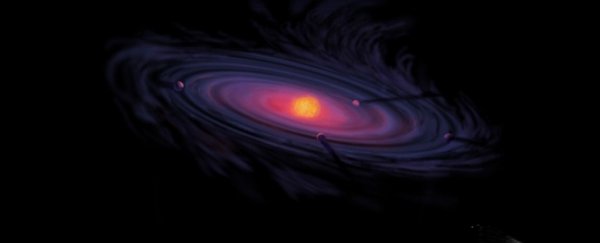The Solar System has been here for a long time. So, when 'Oumuamua was spotted in 2017, it was almost a dead cert it wasn't the only object from interstellar space to visit us over that 4.57 billion-year history. Then comet 2I/Borisov showed up last year. That basically clinched it.
But where are the rest of our interstellar visitors? We'll probably find a few more flying in from the wilds in the coming years. And, according to new research, a whole bunch of interstellar asteroids have been hanging out right here in the Solar System for a very long time.
Based on how they move around the Sun, a team of researchers has identified 19 asteroids they think were captured from another star, way back when the Solar System was just a few million years old.
Back then, astronomers believe, the Sun was part of a stellar nursery, a cluster of stars being born close together of the same cloud of gas and dust.
"The close proximity of the stars meant that they felt each others' gravity much more strongly in those early days than they do today," explained astronomer and cosmologist Fathi Namouni of the Observatoire de la Côte d'Azur in France.
"This enabled asteroids to be pulled from one star system to another."
Fathi and his colleague astronomer Helena Morais of the Universidade Estadual Paulista in Brazil found their first permanent interstellar resident in 2018. They were looking into a group of asteroids called the Centaurs, which hang out between Jupiter and Neptune, and often have really weird orbits.
One asteroid called 2015 BZ509 - later named Kaʻepaokaʻawela - was on a weirder orbit than most - exactly the same as Jupiter's, but in the opposite direction, or retrograde. If it was native to the Solar System, it should have been travelling in the same direction as everything else, so the team ran simulations to discover its origins.
They found that Kaʻepaokaʻawela's most likely origin was interstellar space, and it had been captured into the Solar System 4.5 billion years ago.
In the new study, the team examined Centaurs and trans-Neptunian objects with high orbital inclination relative to the orbital plane of the planets, sometimes bringing them close to a polar orbit. And, like Kaʻepaokaʻawela, some of these objects also have retrograde orbits.
"With moderate to high eccentricities, Centaurs' orbits may be inclined by a few degrees with respect to the Solar System's invariable plane to almost 180° resulting in retrograde motion," the researchers wrote in their paper.
"Their orbital features are often taken as a sign of their violent past in the Solar System, a notion reinforced by their so-called instability. If a Centaur orbit is integrated forward or backward in time, it will invariably either hit the Sun, the planets, or be ejected from the Solar System."
The study included 17 Centaurs with orbital inclinations greater than 60 degrees, and two objects that orbit past Neptune, or trans-Neptunian objects. The researchers used the known orbits of these objects to create multiple clones of each one to simulate their orbits back in time - arriving at 4.5 billion years ago.
At this time, the stuff in our Solar System was all more or less in a flat disc around the Sun, leftover from the young star's accretion disc. It should have all been orbiting on around the same plane, and in the same direction.
But, according to the team's simulations, these 19 asteroids weren't a part of that tidy disc. Most of the clones did indeed end up smashing into the Sun or getting kicked out of the Solar System. Fewer ended up smashing into a planet. Even fewer still maintained a stable orbit… however, since those asteroids are here today, they must have beaten the odds, according to this model.
But those that did achieve a stable orbit did not start out in the Sun's disc. Not only were they far beyond the disc's outskirts, but the orbits were perpendicular to it.
This, the researchers said, means that the probability the asteroids were captured by the Sun's gravity from outside the Solar System is higher than the probability they were born here, with the rest of the Solar System's rocks, out of the Sun's leftovers.
Future study of these rocks could help validate the team's findings; from there, they could help us identify more interstellar interlopers, which in turn could help us learn more about the formation of the Solar System, as well as other planetary systems.
"The discovery of a whole population of asteroids of interstellar origin is an important step in understanding the physical and chemical similarities and differences between Solar System-born and interstellar asteroids," Morais said.
"This population will give us clues about the Sun's early birth cluster, how interstellar asteroid capture occurred, and the role that interstellar matter had in chemically enriching the Solar System and shaping its evolution."
The research has been published in the Monthly Notices of the Royal Astronomical Society.
